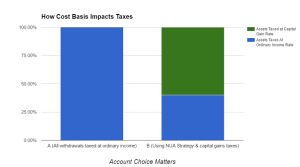Taking a Loan from Your Retirement Plan = Bad Idea
Taking a Loan from Your Retirement Plan = Bad Idea
Why you should refrain from making this move.
Thinking about borrowing money from your 401(k), 403(b), or 457 account? Think twice about that because these loans are not only risky but injurious to your retirement planning.
A loan of this kind damages your retirement savings prospects. A 401(k), 403(b), or 457 should never be viewed like a savings or checking account. When you withdraw from a bank account, you pull out cash. When you take a loan from your workplace retirement plan, you sell shares of your investments to generate cash. You buy back investment shares as you repay the loan. (1)
In borrowing from a 401(k), 403(b), or 457, you siphon down invested retirement assets, leaving a smaller account balance that experiences a smaller degree of compounding. In repaying the loan, you will likely repurchase investment shares at higher prices than in the past – in other words, you will be buying high. None of this makes financial sense. (1)
Most plan providers charge an origination fee for a loan (it can be in the neighborhood of $100), and of course, they charge interest. While you will repay interest and the principal as you repay the loan, that interest still represents money that could have remained in the account and remained invested. (1,2)
As you strive to repay the loan amount, there may be a financial side effect. You may end up reducing or suspending your regular per-paycheck contributions to the plan. Some plans may even bar you from making plan contributions for several months after the loan is taken. (3,4)
Your take-home pay may be docked. Most loans from 401(k), 403(b), and 457 plans are repaid incrementally – the plan subtracts X dollars from your paycheck, month after month, until the amount borrowed is fully restored. (1)
If you leave your job, you will have to pay 100% of your 401(k) loan back. This applies if you quit; it applies if you are laid off or fired. Formerly, you had a maximum of 60 days to repay a workplace retirement plan loan. The Tax Cuts & Jobs Act of 2017 changed that for loans originated in 2018 and years forward. You now have until October of the year following the year you leave your job to repay the loan (the deadline is the due date of your federal taxes plus a 6-month extension, which usually means October 15). You also have a choice: you can either restore the funds to your workplace retirement plan or transfer them to either an IRA or a workplace retirement plan elsewhere. (2)
If you are younger than age 59½ and fail to pay the full amount of the loan back, the I.R.S. will characterize any amount not repaid as a premature distribution from a retirement plan – taxable income that is also subject to an early withdrawal penalty. (3)
Even if you have great job security, the loan will probably have to be repaid in full within five years. Most workplace retirement plans set such terms. If the terms are not met, then the unpaid balance becomes a taxable distribution with possible penalties (assuming you are younger than 59½. (1)
Would you like to be taxed twice? When you borrow from an employee retirement plan, you invite that prospect. You will be repaying your loan with after-tax dollars, and those dollars will be taxed again when you make a qualified withdrawal of them in the future (unless your plan offers you a Roth option). (3,4)
Why go into debt to pay off debt? If you borrow from your retirement plan, you will be assuming one debt to pay off another. It is better to go to a reputable lender for a personal loan; borrowing cash has fewer potential drawbacks.
You should never confuse your retirement plan with a bank account. Some employees seem to do just that. Fidelity Investments says that 20.8% of its 401(k) plan participants have outstanding loans in 2018. In taking their loans, they are opening the door to the possibility of having less money saved when they retire. (4)
Why risk that? Look elsewhere for money in a crisis. Borrow from your employer-sponsored retirement plan only as a last resort.
 Justin D. Rucci, CFP®
Justin D. Rucci, CFP®
Wealth Advisor
Warren Street Wealth Advisors
Justin is an Investment Advisor Representative of Warren Street Wealth Advisors, a Registered Investment Advisor. The information contained herein does not involve the rendering of personalized investment advice but is limited to the dissemination of general information. A professional advisor should be consulted before implementing any of the strategies or options presented.
This material was prepared by MarketingPro, Inc., and does not necessarily represent the views of the presenting party, nor their affiliates. This information has been derived from sources believed to be accurate. Please note – investing involves risk, and past performance is no guarantee of future results. The publisher is not engaged in rendering legal, accounting or other professional services. If assistance is needed, the reader is advised to engage the services of a competent professional. This information should not be construed as investment, tax or legal advice and may not be relied on for avoiding any Federal tax penalty. This is neither a solicitation nor recommendation to purchase or sell any investment or insurance product or service, and should not be relied upon as such. All indices are unmanaged and are not illustrative of any particular investment.
Any investments discussed carry unique risks and should be carefully considered and reviewed by you and your financial professional. Past performance may not be indicative of future results. All investment strategies have the potential for profit or loss. Changes in investment strategies, contributions or withdrawals may materially alter the performance, strategy, and results of your portfolio. Historical performance results for investment indexes and/or categories, generally do not reflect the deduction of transaction and/or custodial charges or the deduction of an investment-management fee, the incurrence of which would have the effect of decreasing historical performance results. Economic factors, market conditions, and investment strategies will affect the performance of any portfolio and there are no assurances that it will match or outperform any particular benchmark. Nothing in this commentary is a solicitation to buy, or sell, any securities, or an attempt to furnish personal investment advice. We may hold securities referenced in the blog and due to the static nature of the content, those securities held may change over time and trades may be contrary to outdated posts.
Citations
1 – gobankingrates.com/retirement/401k/borrowing-401k/ [10/7/17]
2 – forbes.com/sites/ashleaebeling/2018/01/16/new-tax-law-liberalizes-401k-loan-repayment-rules/ [1/16/18]
3 – cbsnews.com/news/when-is-it-ok-to-withdraw-or-borrow-from-your-retirement-savings/ [1/31/17]
4 – cnbc.com/2018/06/26/the-lure-of-a-401k-loan-could-mask-its-risks.html [6/26/18]



